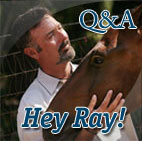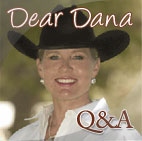Diligence and consistency can work through ‘buddy sour’ behavior
“The hardest part of teaching is to get people to push past their comfort zone, but that is where growth takes place.”
 Some horses are independent. They exhibit a low level of separation anxiety that can be handled easily by the rider. Other horses display a strong herd-bound mentality that, when separated from their companions, creates an almost dangerous behavior.
Some horses are independent. They exhibit a low level of separation anxiety that can be handled easily by the rider. Other horses display a strong herd-bound mentality that, when separated from their companions, creates an almost dangerous behavior.
This is partly their personality, and just like people, horses have different traits. However, whenever you interact with your horse, you are either (A) supporting or (B) correcting the behavior.
Repetition + Conformation Challenges + Fatigue = Injuries
"Awareness is crucial to the recovery of any injury. Keep vigilant of any changes in your horse's behavior and take up any concerns with your vet."
 Athletes who play sports are susceptible to injuries specific to that sport. Common basketball injuries include ankle sprains and shin splints. Football injuries include shoulder separations and torn rotator cuffs. Horses are athletes, too, and whether you ride trail or perform in a specific discipline, injuries will occur when there is repetitive use, conformation challenges, and fatigue.
Athletes who play sports are susceptible to injuries specific to that sport. Common basketball injuries include ankle sprains and shin splints. Football injuries include shoulder separations and torn rotator cuffs. Horses are athletes, too, and whether you ride trail or perform in a specific discipline, injuries will occur when there is repetitive use, conformation challenges, and fatigue.
In addition to starting colts, I do get a lot of problem horses to remedy with issues like bucking, rearing and bolting. The first thing I want to rule out is pain. I will ask a great deal of questions pertaining to the specific problem such as when it began, where does it occur and has the horse’s demeanor changed. If there is anything that points to pain, I will require a lameness exam. When starting colts, I require teeth to be floated and wolf teeth removed prior to their arrival. Awareness is crucial to the recovery of any injury. Keep vigilant of any changes in your horse’s behavior and take up any concerns with your vet.
Getting to your goals: Don’t settle – make improvements!
"You cannot make changes by focusing on what isn’t working; you make changes when you determine what you want to see happen, and then be open to trying something different."
 If you want to see a different result, an improvement in your riding ability, or an improvement with a specific issue that you experience with your horse — no matter how big or small – then you need to make a change in your current approach. Learn to break down the task into smaller components that your horse can better understand.
If you want to see a different result, an improvement in your riding ability, or an improvement with a specific issue that you experience with your horse — no matter how big or small – then you need to make a change in your current approach. Learn to break down the task into smaller components that your horse can better understand.
They say the definition of madness is to do the same thing over and over, yet expect different results. You need to change the formula.
Know your horse and become a leader that he or she will respect
I use affection and praise for the correct responses to build confidence, reinforce boundaries and establish leadership.
 Anthropomorphism is a term used to describe people attaching human emotions to animals. It’s something commonly found in the horse world, and it often creates stumbling blocks in training programs.
Anthropomorphism is a term used to describe people attaching human emotions to animals. It’s something commonly found in the horse world, and it often creates stumbling blocks in training programs.
For example, an owner may interpret a horse’s habit of crowding their space as a way of showing affection, but if the owner understood the nature of horses, they’d recognize that the horse is attempting to establish dominance. In this case, as the pecking order goes, the owner is on the bottom and the horse on top. By not setting clear boundaries and correcting disrespectful behavior for fear of not being liked, you are on the way to creating a dangerous scenario because the severity of this behavior will increase over time if left unchecked. It’s important to be a leader that your horse will respect.
A correct match between horse and rider is the difference-maker
The right direction: always seeking improvement
 One aspect of horse training that I appreciate is the never-ending opportunity to grow and strengthen one’s abilities. As a trainer, I continue to seek out professionals who help me expand my own knowledge and skills in disciplines and areas that are of interest to me. My motivation is simple: I want to provide my best effort to the horses that my clients have entrusted to me. There are numerous disciplines that have evolved and specialized over the years, such as cutting, reined cow horse, Western dressage and ranch pleasure to name a few. They all share a common thread– developing a higher level of horsemanship.
One aspect of horse training that I appreciate is the never-ending opportunity to grow and strengthen one’s abilities. As a trainer, I continue to seek out professionals who help me expand my own knowledge and skills in disciplines and areas that are of interest to me. My motivation is simple: I want to provide my best effort to the horses that my clients have entrusted to me. There are numerous disciplines that have evolved and specialized over the years, such as cutting, reined cow horse, Western dressage and ranch pleasure to name a few. They all share a common thread– developing a higher level of horsemanship.
Look for improvements – not perfection – in fixing behaviors
 Bad attitudes result in bad behaviors. If you aren’t able to determine the cause and make appropriate corrections, then bad behaviors never stay at the same level — they escalate. What was a reluctance to go forward will progress into bucking or rearing. Ear-pinning while being cinched will progress into nipping. Confused spooking can result in bolting.
Bad attitudes result in bad behaviors. If you aren’t able to determine the cause and make appropriate corrections, then bad behaviors never stay at the same level — they escalate. What was a reluctance to go forward will progress into bucking or rearing. Ear-pinning while being cinched will progress into nipping. Confused spooking can result in bolting.
Partnering up: Some Do’s and Don’ts that will keep you safe
 Where does a successful and safe horse-and-rider relationship begin? In the very beginning, when the two are partnered up.
Where does a successful and safe horse-and-rider relationship begin? In the very beginning, when the two are partnered up.
Correct partnering between horse and rider is essential to create a relationship in which both can develop confidence, expand their abilities and enjoy the experience. If you are looking to purchase a horse, do some soul-searching. Think about what discipline most interests you and complements your lifestyle, ability and budget. If you enjoy riding trail, look for an experienced trail horse, not a Thoroughbred off the track because he is pretty. It’s easy for color to draw your attention away from the original plan, too, and get you off course. That color may cost you down the road, either in training fees that you hadn’t budgeted for, doctor bills, or the emotional toll of losing your confidence and becoming fearful of being on the back of a horse — no longer a place of refuge, but a place of dread.
In the round pen: Let’s start training your driving horse
 When starting the equine, a controlled environment is necessary, such as a smaller arena or a round pen. This is where I like to introduce to the equine yielding to pressure; use of the whip and the vocal commands: walk, trot, WHOA. I use a combination of theories of ‘Natural’, ‘Resistance Free’ horsemanship and the German Training scale. There are other methods of training, and as with any type of training, you must choose what methods work best for you. For this portion of training, the horse can be “free lunging” with no equipment necessary. No harness is needed at this point in training, and we’ll introduce it and the blinders in time as we progress in the round pen.
When starting the equine, a controlled environment is necessary, such as a smaller arena or a round pen. This is where I like to introduce to the equine yielding to pressure; use of the whip and the vocal commands: walk, trot, WHOA. I use a combination of theories of ‘Natural’, ‘Resistance Free’ horsemanship and the German Training scale. There are other methods of training, and as with any type of training, you must choose what methods work best for you. For this portion of training, the horse can be “free lunging” with no equipment necessary. No harness is needed at this point in training, and we’ll introduce it and the blinders in time as we progress in the round pen.
Tightening the reins is no answer for jigging out on trail
 Jigging out on trails stems from a few different causes Ð buddy sour, barn sour, competitive (always wanting to be in front) or bored because they have not been worked sufficiently to expend their energy. Whatever the cause, the least effective way to correct this behavior is to tighten up the reins, hang on the mouth and try to restrict their movement. You cannot force a horse to walk when all they want to do is jig.
Jigging out on trails stems from a few different causes Ð buddy sour, barn sour, competitive (always wanting to be in front) or bored because they have not been worked sufficiently to expend their energy. Whatever the cause, the least effective way to correct this behavior is to tighten up the reins, hang on the mouth and try to restrict their movement. You cannot force a horse to walk when all they want to do is jig.
You have to change their mind by turning what they want to do into work, and turning what you want to do into rest. In order accomplish this, you have to make their feet move with energy and change direction frequently, thus keeping their attention on you.



 Read Columns
Read Columns

